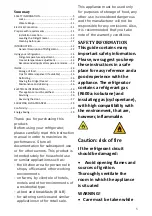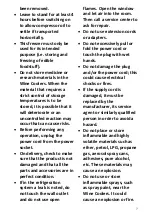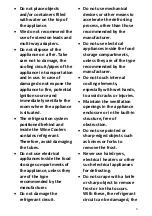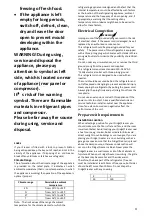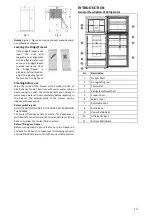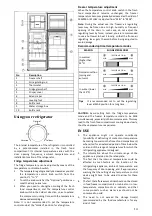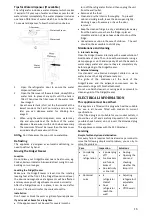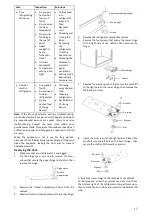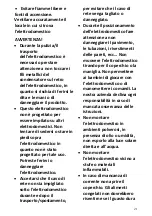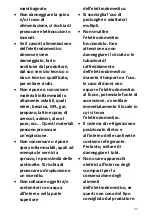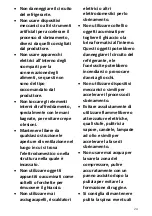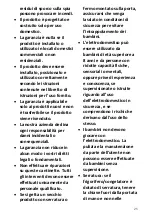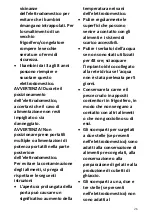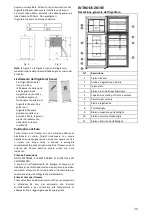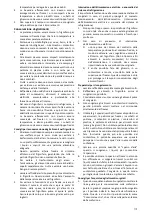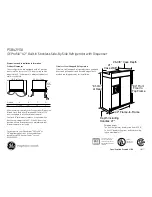
16
Tips for Water dispenser (If available)
The refrigerator includes a water dispenser which makes
it easier to fill your cup of water and have access to cold
water almost immediately. The water dispenser includes
one tank of
2.5
litres of water which has to be filled out.
To use water dispenser, follow the instructions below:
1.
Open the refrigerator door to ensure the water
dispenser fixed well.
2.
Open the filler cover of the water tank, slowly fill the
water tank to prevent any spills until the tank is
filled. Then close the filler cover of the water tank.
See image C.
3.
Once the water tank is full, set the thermostat at the
lowest mode or the Fast Cool mode, and one hour
later you can dispense water for drinking. See
image D.
4.
When using the water dispenser, some water may
drip and accumulate at the bottom of the water
dispenser. Please wipe it with a cloth when necessary.
5.
The maximum fill must be lower than the tank cover
as indicated by the maximum fill line.
NOTE
:
Don't take away the cup until no waterdrop.
Defrosting
This appliance is designed as automatic defrosting, no
need to defrost by hand.
Moving the Fridge/Freezer
Location
Do not place your Fridge/Freezer near a heat source, eg.
Cooker, boiler or radiator. Also avoid direct sunlight in out-
buildings or sun lounges.
Leveling the Fridge/Freezer
Make sure the Fridge/Freezer is level. Use the rotating
leveling feet at the front. If the Fridge/Freezer is not level,
the doors and magnetic seal alignments will be affected
and may cause your Fridge/Freezer to work incorrectly.
After the Fridge/Freezer is in place, it can be used after
4 hours. This allows time for the coolant to settle.
Installation
Don’t cover or block the vents or grilles of your appliance.
If you're not at home for a long time
•
If the appliance will not be used for several months,
turn off the refrigerator first and then unplug the unit
from the wall outlet.
•
Remove all the food.
•
Clean and dry the interior thoroughly. To prevent
odor and mold growth, leave the door open slightly:
blocking it open if necessary or have the door
removed.
•
Keep the cleaned fridge in a dry, ventilated place away
from the heat source, where the fridge is placed
smoothly and do not place heavy objects on top of the
fridge.
•
Use extreme caution in the case of children. The unit
should not be accessible to child’s play.
Maintenance and cleaning
1. Internal cleaning
Clean the Fridge/Freezer internally with a weak solution of
bicarbonate of soda. Then rinse with warm water using a
damp sponge or cloth and wipe dry. Wash the baskets in
warm soapy water and ensure they are completely dry
before replacing in the Fridge/Freezer.
2. External cleaning
Use standard non-abrasive detergent diluted in warm
water to clean the Fridge/Freezer exterior.
The grille of the condenser at the back of the
Fridge/Freezer and the adjacent components can be
vacuumed using a soft brush attachment.
Do not use harsh cleaners, scouring pads or solvents to
clean any part of the Fridge/Freezer
ELECTRICAL INFORMATION
This appliance must be earthed.
This appliance is fitted with a plug which will be suitable
for use in all houses fitted with sockets to current
specifications.
If the fitted plug is not suitable for your socket outlets, it
should be cut off and carefully disposed of. To avoid a
possible shock hazard, do not insert the discarded plug
into a socket.
This appliance complies with the EEC Directives.
Servicing
Simple fault analysis and elimination
Not every failure requires technical service personnel to
solve the following simple small problem; you can try to
solve the problem.
Case
Inspection
Solutions
•
Completely
non
refrigeration
•
Is power plug
off?
•
Are breakers
and fuses a
broken?
•
No electricity
or line trip?
•
Re-plug.
•
Opening the
door and
checking
whether the
lamp is lit.
•
Abnormal
noise
•
Is
refrigerator
stable?
•
Does
refrigerator
reach the
wall?
•
Adjusting
refrigerator’s
adjustable
feet.
•
Off the wall.
Filler cover
Water tank cover
Water tank
close
open
Water
switch




